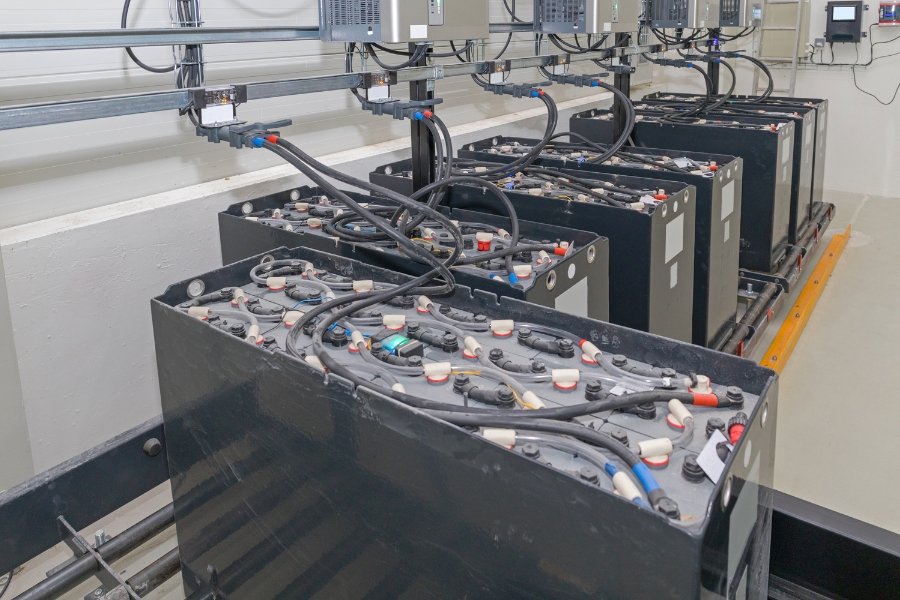A dead battery is always annoying: TV remote not working, fire alarm beeping at 3 a.m., etc. When that dead battery was supposed to power a forklift for the day, it is especially irritating. One of the main causes of your lead acid batteries not holding a charge is battery sulfation.
Battery sulfation is a common issue that significantly impacts a battery’s performance and lifespan.
What is a sulfated battery?
A lead acid battery is composed of hundreds of cells, each containing a lead anode and a lead cathode submerged in an electrolyte solution that’s a mix of sulfuric acid and water. As part of the reactions to generate electricity, the sulfuric acid splits into sulfate and hydrogen atoms. Sulfate is attracted to lead, and it bonds to either the anode or cathode to form lead sulfate. When the battery is recharged, the process reverses, meaning the sulfate splits from the lead and returns to the electrolyte solution.
However, when a battery is undercharged or deprived of a full charge, some of the hardened lead sulfate remains on the lead plates. Once the buildup of these battery crystals begins, it continues with every use, resulting in a sulfated battery.
You can’t see the damage to a sulfated battery without opening the battery. However, some common performance issues indicate battery sulfation, such as:
- Reduced runtime.
- Being unable to hold a charge.
- Longer charge times (sulfation increases resistance within the battery, making it difficult for the battery to accept and store a charge).
- Difficulty starting your forklift.
- Low battery voltage.
- Poor performance in cold weather (winter conditions already reduce a battery’s capacity; when combined with sulfation, the performance can be further compromised).
- Corrosion (sulfation can cause the battery’s internal components to deteriorate, leading to an acid leak).
- Bulging or swollen battery case (which indicates severe sulfation and that the battery needs to be replaced).
What does sul mean on a battery charger?
Some battery chargers can identify a sulfated battery with the sul error code. Some of the sul status indicators include:
- F01—Battery voltage is less than 10.
- F02—The charger is unable disulfate.
- F03—The battery is unable to be fully charged.
- F04—Reversed connection.
- F05—Unable to maintain charge/decrease efficacy.
Can you charge a sulfated battery?
Short answer, “Yes, with an if;” long answer, “No, with a but.”
As long as there is no external damage (such as corrosion or a bulging case), you can charge a sulfation battery. However, there is no guarantee that the charge will last or even take.
Also, it is important to use caution. Charging a sulfated battery can generate excessive heat, which can continue to damage the battery or create a dangerous workplace situation.
How to desulfate battery corrosion
The answer to how to reverse battery sulfation is that it’s not always possible. Some damage, known as “hard” sulfation, is irreversible; the only solution is to purchase a new battery. However, when the sulfation is “soft,” there are techniques that could help salvage the battery.
Sometimes, a long and slow charging cycle with a low current can dissolve the lead sulfate crystals and revive the battery. This method aims to restore the battery’s functionality by breaking down the hardened sulfates and allowing them to recombine with the electrolyte.
Another technique, known as equalization charging, involves applying a carefully controlled overcharge to the battery, typically at a slightly higher voltage than the battery’s standard charging voltage. This extended charging process helps break down and dissolve the lead sulfate crystals, allowing the battery to recover its capacity and performance. It is essential to follow the manufacturer’s guidelines and recommendations to prevent overcharging and potential damage.
There are also specialized desulfation devices that employ high-frequency pulses and chemical additives to dissolve or reduce the sulfation buildup on the battery plates. The high-frequency pulses break down lead sulfate crystals, and the chemical additives help dissolve them.
It is also possible to physically remove lead sulfate by physically shaking or vibrating a battery to dislodge the lead sulfate crystals from the plates. This technique should only be performed by a professional because inexperienced, vigorous shaking can damage the delicate battery plates.
Preventing battery sulfation
The only way to prevent battery sulfation is through a routine battery maintenance schedule that ensures the batteries are regularly charged and avoids deep discharges. You should follow the manufacturer guidelines to ensure proper charging procedures because maintaining optimal charge levels helps prevent sulfation from occurring.
Also, avoid exposing lead acid batteries to extreme temperatures. High temperatures can accelerate sulfation. So, store your batteries in a cool, dry environment when they are not in use.
Now that you better understand what is battery sulfation, one of your best options to avoid it is with Texas Motive Solutions’ preventive maintenance program. During convenient, regularly scheduled visits, we address all forklift battery issues before they become problems, so you can keep repair costs in check and help protect the safety of your warehouse staff.
Texas Motive Solutions also offers a complimentary forklift fleet performance analysis to ensure you have the correct batteries for your needs to keep your fleet running at its highest performance.
For all your forklift repair and maintenance needs, give us a call at (888) 316-2459. Please fill out this form to learn about our services and discover everything Texas Motive Solutions can do for you.



